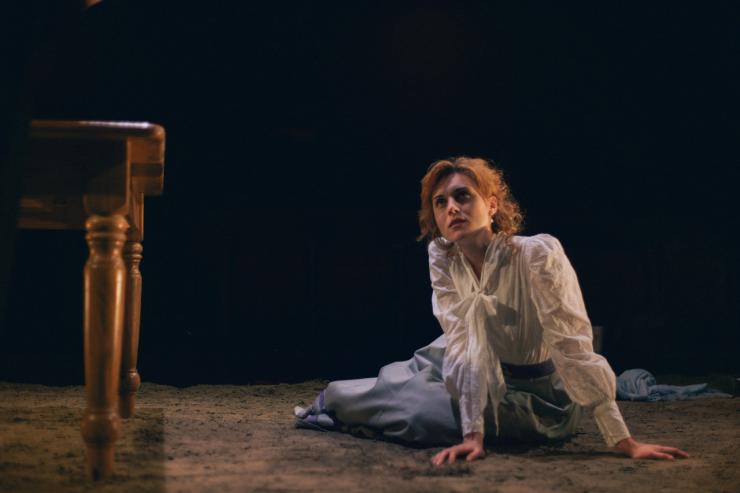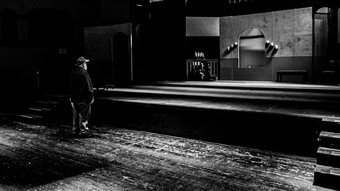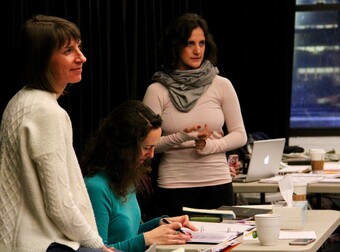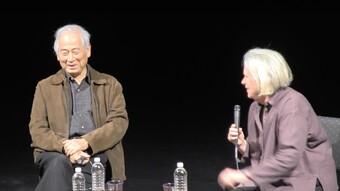Reclaiming Miss Julie
on Interpreting Classic Drama
Despite the reputation it has as a dated, dull, and problematic play, littered with regressive ideas about gender and class, Miss Julie has held an unusual place in the theatrical canon: instantly reviled, while holding some of the most envied challenges for actors eager to test themselves against classic material. The play is revived every season with major productions continually coming from international and local artists. Within the last couple of years the Lincoln Center Festival presented Thomas Ostermeier’s Russian adaptation, which reset the action to a modern day Russian kitchen; Yael Farber’s Mies Julie brought the play to a South African farm coming to terms with the after-effects of apartheid; and Liv Ullman changed the setting to turn of the century Ireland in her film adaptation. Its lingering influence can be seen in the work of Tennessee Williams, Eugene O’Neill, Sarah Kane, John Osborne, and other playwrights who have captivated the modern world. Divided opinions aside, it is hard to deny that many artists feel the impulse to work on Strindberg’s most famous play. My recent experience directing it made me ask many difficult questions about the play, as well as about directing classical drama in general.
As a director preparing to work on this play, I wanted to avoid the easy solution of contextualization. To justify the actions and thoughts in the play by saying that we have since developed past them felt uninteresting.
Strindberg presents a world that is unapologetically misogynistic and classist; values that are contrary, if not polar opposites, to our contemporary ideals. It doesn’t help that in the preface of his play he describes his heroine as “a man hating, half woman” who “unfortunately has the power of reproducing itself and its misery…”
As a director preparing to work on this play (running at the Access Theater in New York City through May 21, 2017), I wanted to avoid the easy solution of contextualization. To justify the actions and thoughts in the play by saying that we have since developed past them felt uninteresting; like an excuse to do the play without engaging in how it can and will be received now. The challenge was to look within the events of the text to find insights that somehow address the conversations that are happening within our contemporary world. This began the hard work of artistic dialogue and interpretation.
I eventually came upon several insights into the text that helped develop my understanding of the play and were useful in a design process and for actors. The space of the play represented the lower-class and the shame that comes from occupying this role. The text referred to dirt as a symbol of this shame. As Julie enters the space she becomes dirty and Jean uses the words “dirt” and “filth” as ways of shaming Julie for who she is and what she has done. This reoccurring image in the text became the main concept for the design.

It was also important to me that the production not present Jean and Julie as foolish for having the dreams that they do. They are two people who are unable to locate themselves within the world they are living in. A breakthrough in understanding the character of Julie came from an interview on the popular radio-show On Being with Joy Ladin, a transwoman who works at Yeshiva University. Her insightful descriptions of socialization and what it is like to be gender non-conforming within a conservative institution resonated with Julie’s character. Although Julie is a biological woman who is attracted to men, she doesn’t conform to her assigned gender role. She was socialized as a boy for the early part of her life and then, suddenly, forced into a traditional upbringing as a girl. Having been socialized as both a boy and girl left her lost and unable to cope within the rigid world that she lives in. Jean is just as lost in his life. He feels himself to be both upper and lower class. He is intelligent enough to understand what is assumed to be the territory of the educated upper-class: foreign languages, theatre, literature, fine dining, and the like. It is absurd to him that he must submit to people who are capable of no more than he is.
This reading helped bring three dimensions to the characters and brought out Julie’s talk of being Jean’s equal. This is exactly what the two of them want: to break free from the constraints of the lives they were born into and become each other’s equal. They want the kind of control over their lives that they are deprived of. The first part of the play dramatizes their attempt to destroy the barriers of gender and class in order to gain this control. The second part of the play shows the failure of this attempt.

The last big insight came from Strindberg himself. He once commented that there can be no such thing as revolution. He believed that everything must be burned before it can start over again. While Jean and Julie long to live lives outside of the constraints of their class and sex, they are also unable to survive without them. Without his role as a servant, Jean loses his pension, paycheck, and livelihood. His dream of a hotel is quixotic. When faced with this reality he claims pride in his working-class status. Julie loses all of her power when she steps out of her upper-class role, and her privilege hasn’t prepared her to create a life for herself where she isn’t taken care of by servants. As much as they defy the positions they are born into, they are also dependent on them.
It is difficult work bringing classic plays to modern audiences. The times are different, the languages are different, the world represented is not instantly recognizable to us now. These texts are cultural artifacts and, in many cases, should be treated as such, but we as theatre artists are trying to make something that lives and breathes in the current moment, not in the past. For those that try to tackle the works that form our canon, it is our task to find new meaning within the play, even the difficult parts, as opposed to justifying it away. The friction that this creates is both fertile and terrifying ground. The questions provoked can change with the times, even if the text does not. This work, although difficult, can shed light on where we are now and give artistic expression to what our human cultures still struggle with and may always struggle with.
Strindberg held opposing opinions on every issue he was ever asked about (which were a lot). There is no question of whether he was a likeable man or not: he wasn’t. But he wrote from within the fire of conflict. His own torn identity, his own struggles with his marriage, and his reoccurring spiritual crises all make an appearance in his writing. He doesn’t write about solutions or better worlds. He writes from within the violent struggle that leads, hopefully, towards one.










Comments
The article is just the start of the conversation—we want to know what you think about this subject, too! HowlRound is a space for knowledge-sharing, and we welcome spirited, thoughtful, and on-topic dialogue. Find our full comments policy here